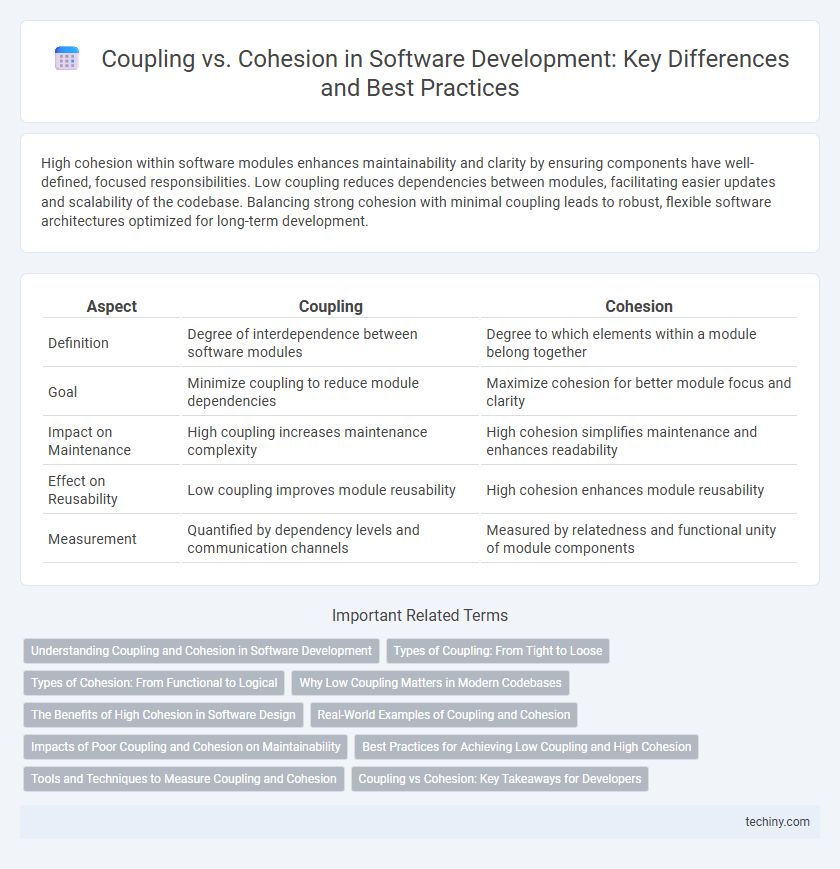High cohesion within software modules enhances maintainability and clarity by ensuring components have well-defined, focused responsibilities. Low coupling reduces dependencies between modules, facilitating easier updates and scalability of the codebase. Balancing strong cohesion with minimal coupling leads to robust, flexible software architectures optimized for long-term development.
Table of Comparison
| Aspect | Coupling | Cohesion |
|---|---|---|
| Definition | Degree of interdependence between software modules | Degree to which elements within a module belong together |
| Goal | Minimize coupling to reduce module dependencies | Maximize cohesion for better module focus and clarity |
| Impact on Maintenance | High coupling increases maintenance complexity | High cohesion simplifies maintenance and enhances readability |
| Effect on Reusability | Low coupling improves module reusability | High cohesion enhances module reusability |
| Measurement | Quantified by dependency levels and communication channels | Measured by relatedness and functional unity of module components |
Understanding Coupling and Cohesion in Software Development
Coupling in software development refers to the degree of interdependence between modules, where low coupling minimizes the impact of changes and improves module independence. Cohesion measures how closely related and focused the responsibilities of a single module are, with high cohesion enhancing maintainability and clarity. Understanding the balance between low coupling and high cohesion is essential for designing modular, scalable, and robust software systems.
Types of Coupling: From Tight to Loose
Types of coupling in software development range from tight to loose, impacting system modularity and maintainability. Tight coupling involves high dependency between modules, such as content coupling where one module directly modifies another's data, leading to fragile code. Loose coupling, exemplified by message coupling through well-defined interfaces or event-driven architectures, promotes independent module development and enhances scalability.
Types of Cohesion: From Functional to Logical
Functional cohesion occurs when all elements of a module work together to perform a single well-defined task, enhancing maintainability and reliability. Sequential cohesion links elements by the output of one acting as the input for the next, promoting structured data flow within the module. Logical cohesion groups related operations under the same module based on a control logic, which may reduce clarity but can improve modular reusability for decision-based processing.
Why Low Coupling Matters in Modern Codebases
Low coupling in modern codebases enhances maintainability by minimizing dependencies between modules, allowing individual components to be modified or replaced without widespread impact. This separation improves testability, enabling isolated unit tests that increase code reliability and facilitate faster development cycles. Furthermore, low coupling supports scalability and adaptability, allowing software systems to evolve as requirements change while reducing the risk of introducing bugs.
The Benefits of High Cohesion in Software Design
High cohesion in software design enhances maintainability by ensuring that modules encapsulate closely related functionalities, making code easier to understand and modify. It reduces complexity and increases reusability, as highly cohesive components exhibit well-defined responsibilities and clear interfaces. Improved testing efficiency and fault isolation are direct results of high cohesion, contributing to robust and reliable software systems.
Real-World Examples of Coupling and Cohesion
Low coupling is exemplified by a modular billing system where the payment module operates independently of the user interface, enabling easy updates without affecting other components. High cohesion is demonstrated in a customer service module that encapsulates all related functions such as account management, inquiry handling, and complaint resolution, ensuring focused functionality. These principles improve maintainability and scalability by minimizing interdependencies and grouping related responsibilities within software components.
Impacts of Poor Coupling and Cohesion on Maintainability
Poor coupling and cohesion significantly degrade software maintainability by increasing complexity and reducing clarity. Tight coupling causes modules to be highly interdependent, making changes risky and time-consuming, while low cohesion results in modules performing unrelated tasks that obscure purpose and complicate debugging. These issues lead to elevated defect rates, longer development cycles, and higher maintenance costs.
Best Practices for Achieving Low Coupling and High Cohesion
Low coupling in software development is achieved by designing modules with minimal dependencies, using interfaces and dependency injection to allow flexibility and easier maintenance. High cohesion is promoted by grouping related functionalities within a single module, which enhances code readability and simplifies debugging. Adopting principles such as the Single Responsibility Principle (SRP) and modular programming significantly improves software quality by balancing coupling and cohesion effectively.
Tools and Techniques to Measure Coupling and Cohesion
Static analysis tools such as SonarQube and CodeClimate provide metrics to measure coupling and cohesion by analyzing code dependencies and module interactions. Techniques like dependency graphs and class responsibility assignment aid in quantifying coupling by identifying inter-module communication, while cohesion is evaluated using metrics such as Lack of Cohesion of Methods (LCOM) to assess the relatedness of functions within a module. Automated test coverage tools further complement these measurements by highlighting tightly coupled modules through test case dependencies and isolated module functionality through cohesion scores.
Coupling vs Cohesion: Key Takeaways for Developers
Low coupling and high cohesion are essential principles for creating maintainable and scalable software architectures. Coupling measures the degree of interdependence between software modules, where lower coupling reduces complexity and improves module independence. Cohesion indicates how closely related the responsibilities of a single module are, with higher cohesion enhancing readability, reusability, and ease of debugging.
Coupling vs Cohesion Infographic

 techiny.com
techiny.com